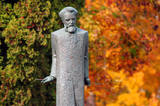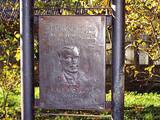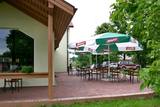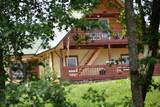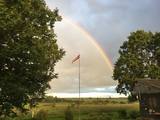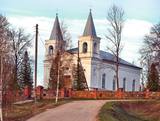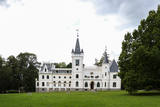| Nr | Nosaukums | Apraksts |
|---|---|---|
|
Limbažos, Cēsu un Dailes ielu krustojumā atrodas Latvijas himnas autoram veltītais piemineklis. Pieminekļa autori ir tēlnieki Z. Rapa un J. Rapa. Pieminekli atklāja 1998. gada 16. maijā, kad Limbažos svinēja 775 gadu jubileju. |
||
|
Diplomēts mežsaimnieks Imants Urpens Alojas novada "Ošlejās" audzē šitaki sēnes. Šī ir arī mācību saimniecība, uz kuru brauc mācīties pārsvarā ārzemnieki. Saimniecība ir bioloģiski sertificēta. Pieņem ekskursijas un pasūtījumus sēņu audzēšanai un micēlija iegādei. |
||
|
Šī skata dēļ ir vērts braukt arī no tālienes. No Latvijas mērogā iespaidīgā reljefa veidojuma paveras tāls skats līdz pat Hānjas augstienei Igaunijā, kur zinātājs atpazīs arī Lielo Munameģi – Baltijas augstāko virsotni.
|
||
|
Muzeja (dibināts 1954. g.) krājums atspoguļo latviešu un lībiešu zvejnieku, jūrnieku un zemnieku tradīcijas, viņu dzīves vidi un veidu. Brīvdabā apskatāmas zvejnieku sētas ar tīklu būdām, dūmnamiem un kūpinātavām, klētīm u.c. Te izvietota zvejas laivu un Baltijā lielākā enkuru (> 100 eksemplāri, lielākais 22 t) kolekcija. Vējdzirnavas atvestas no Užavas pagasta. 19. gs. dzīvojamā „Smiltnieku” mājā apskatāmi autentiski sadzīves priekšmeti. Muzeja jaunākais eksponāts ir gandrīz 100 gadus vecais Lielirbes Baptistu lūgšanas nams. Popularitāti ir ieguvis brauciens (1. maijs – 31. oktobris) ar mazbānīti (sliežu platums 600 mm) pa 1,3 km garo Kalna līniju, kuras galā ir izveidots griezulis. Muzejēka ir uzcelta pēc bijušās Mazirbes dzelzceļa stacijas parauga. Muzeja daļa ietilpst Jūrmalas parkā (bērnu rotaļlaukumi un Enkuru taka). |
||
|
Ķemeru pilsētas iela, kur vislabāk saglabājusies un apskatāma pilsētas koka apbūve. Ja no Karogu ielas nogriezīsimies uz Durbes ielu, nonāksim līdz Miervalža Ķemera muzejam, kas veltīts pazīstamajam Latvijas kultūras darbiniekam (1902. – 1980.) – mācītājam un gleznotājam (Durbes ielā 21). |
||
|
Atrodas ceļa, kas ved uz Miķeļtorņa bāku – līkuma malā. Unikālā ēka (vienīgais lībiešu ciemu krogs ar raksturīgo plānojumu, kas saglabājies līdz mūsdienām) šobrīd atrodas avārijas stāvoklī un apskatāma tikai no ārpuses. Pizes krogs celts 1853. gadā. |
||
|
Dekšāru pagasta muzejs atvērts 1996. gadā. Ekspozīcijas par pagasta,
skolas un kolhozu dibināšanas vēsturi, par ievērojamu cilvēku
dzīvi, kas dzimuši vai darbojušies pagasta teritorijā. Latgales literatūras
kolekcija.
Darba laiks: P. - Piekt: 10.00 – 14.00, S., Sv : slēgts |
||
|
Viena no izcilākajām Latvijas katoļu baznīcām. Tagad redzamais mūra dievnams celts 1761. g. poļu baroka stilā. Saglabājies oriģināls un ļoti krāšņs interjers (18. gs.). Ik gadu šeit notiek garīgās mūzikas pasākumi un poļu kultūras dienas. Gida pavadībā var iepazīt baznīcu un citus ES pierobežas (jābūt līdzi pasei!) tūrisma objektus. |
||
|
Takas sākums atrodas Vidagā, vietā, kur uz Vizlas celts vēsturiskais akmens arkas tilts. 1,2 km garā taka bez marķējuma ved gar pašu upes krastu līdz pat ietekai Gaujā. Redzami skaisti dolomīta atsegumi, nelieli krāčveidīgi ūdenskritumi un iespaidīgais Žākļu dižakmens. |
||
|
Kafejnīca "Krūziņi" atrodas Dundagas centrā, viesu namā „Krūziņi”. Latviešu virtuve: Skābu kāpostu zupa, pelēkie zirņi ar rūgušpienu, cepta bute vai menca, skābzupa ar kartupeli. Īpašais ēdiens: „Biezpiena tornītis” vai krēms no Dundagas pienotavas produktiem. |
||
|
Uzcelts Kaņiera pilskalnā un ir Kaņiera pilskalna takas sastāvdaļa. No torņa paveras izcila Kaņiera ezera dienvidrietumu daļas ainava ar niedru saliņām un nelieliem atklāta ūdens laukumiem. Laba putnu vērošanas vieta. |
||
|
Ļoti ainavisks un izteiksmīgs dižkoks, kas aug bijušās Vīcežu pusmuižas zemēs.
|
||
|
Tūristu nometne, smailīšu noma laivošanai pa Šventosios (Svēto) upi un tās pietekām Vyžuonos, Jaros upēm. Piedāvājumā 4 atsevišķas atpūtas vietas ar teltīm, kurās pieejamas dārza mēbeles, vieta grillēšanai, iesmi, pirts upes krastā, āra tualete, mazgāšanās telpa, bērnu rotaļu, volejbola un futbola laukumi. Lielajā dārzā iespējams uzņemt līdz 50 cilvēkiem. Vieta svinībām, festivālu rīkošanai, sanāksmēm un semināriem. Vienā no mājām ir pirts, kā arī divas Krievu prirtis un kubls upes krastā. Piedāvājumā ēdienu pēc iepriekšēja pieprasījuma. |
||
|
Šis ir viens no 6 ceļojuma maršrutiem sērijā "Baudi laukus!", un tas aicina apmeklēt Lauku Labumus – visdažādāko veidu un nozaru saimniecības un uzņēmumus, kas atvērti apmeklētājiem, piedāvā ekskursijas, nogaršot, apskatīt un iegādāties savus ražojumus. Tur apskatāmi mājdzīvnieki, mūsdienīgas lauku saimniecības, amatnieku darbnīcas, iegādājami lauku produkti – maize, medus, mājas vīns un alus, siers, ogas, augļi, zivis, gaļa, dārzeņi, tējas un citi laukos audzēti labumi. Pa ceļam iespējams ieturēt pusdienaslauku krodziņos. |
||
|
"Bielēs" saimnieko jauna ģimene, kas Rīgas steigu ir nomainījusi pret lauku mieru, vēlas atjaunot pazaudēto saikni ar Zemi, iemācīties saklausīt un sajust gadalaikus, kā arī izveidot pašpietiekamu saimniecību. Saimniekiem patīk viss, kas ir dabisks un varbūt pat nedaudz netradicionāls. Patīk eksperimentēt un nepatīk pilsētas stīvums. |
||
|
Pilsrundālē pa ceļam uz Rundāles pili var apmeklēt Retro auto kolekciju, kur apskatāmi 1939. g. automobiļi un dažādu laiku motocikli. Starp automobiļiem ir arī pasaulē šodien reti sastopami modeļi. Šī ir īstā vieta vēsturisko spēkratu cienītājiem! |
||
|
Dricānu Sv. Sīmaņa un Sv. Jūdas Romas katoļu baznīca uzcelta
augstā uzkalnā 1859. gadā. Ar skaistiem kokgriezumiem rotāts Svētā
Gara altāris, svēto koka statuetes, Sīmaņa – Jūdas glezna, kā vārdā
nosaukta baznīca.
|
||
|
„Akmensrags” ir putniem nozīmīga vieta to migrācijas, ziemošanas, kā arī vasarā – spalvu maiņas laikā. Biežāk sastopamās aizsargājamās sugas – mazais ķīris, brūnkakla un melnkakla gārgale. Teritorija atrodas iepretim Pāvilostas novadam, tās platība ir 25 878 ha. Akmensrags ir kuģotājiem bīstama vieta. Akmensraga bāka (augstums 37,5 m) uzbūvēta 1921. g. Apskatāma no iekšpuses. |
||
|
Celta 19. gs. pirmajā pusē Tjūdoru neogotikas formās. Pils pirmais īpašnieks bija barons Johans Gotlībs fon Volfs. Tā paša gadsimta 70. - 80. gados to pārbūvēja franču neorenesanses stilā. Revolūcijas laikā (1905. g.) pili nodedzināja, bet to atjaunoja, ieviešot tās veidolā jūgendstila formas. Gulbenes novada pašvaldība pēdējo divu gadu laikā ir veikusi atjaunošanas un restaurācijas darbus Stāmerienas pils fasādei, jumtam un logiem. Pils ir atvērta apmeklētājiem. Katru dienu noteiktās stundās uz pils ziemeļu fasādes ir skatāma multimediāla ekspozīcija par par Volfu dzimtu. |
||
|
Dibināts 1959. gadā., 60 skujkoku un 350 lapu koku sugas.
Lāčupītes krastos starp Tukuma – Kolkas ceļu un jūru krasta kāpās atrodas dendrologa Igora Medņa veidotie svešzemju koku un krūmu stādījumi. I. Mednis veica eksperimentus un pētīja - kā vietējiem apstākļiem pielāgojas un aklimatizējas dažādas svešzemju augu sugas. Te vērts ierasties maijā un jūnijā, kad zied rododendri.
|
||
